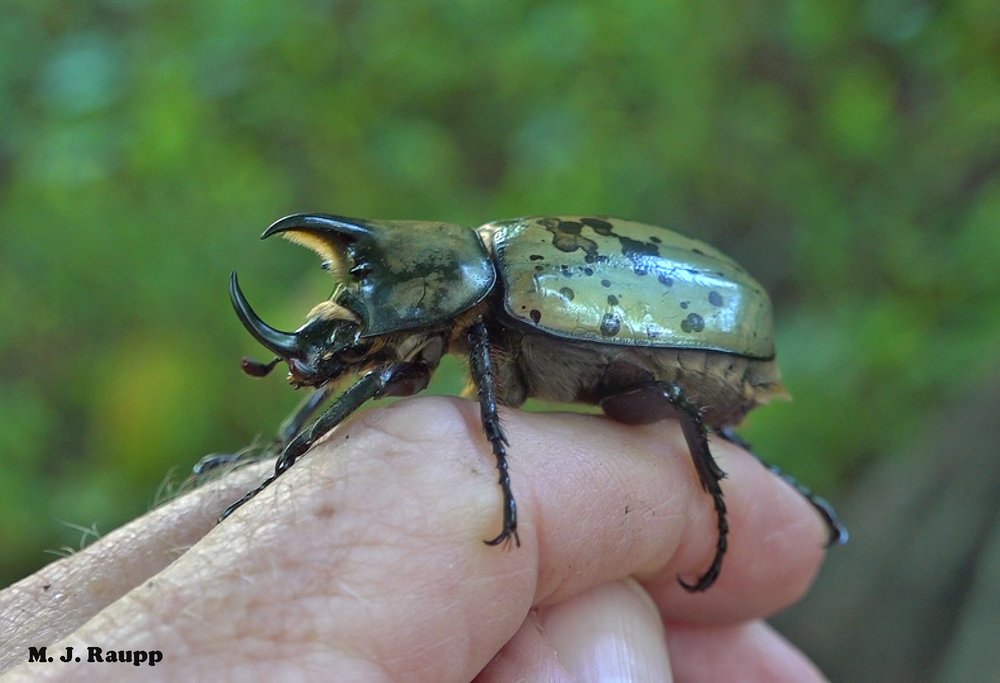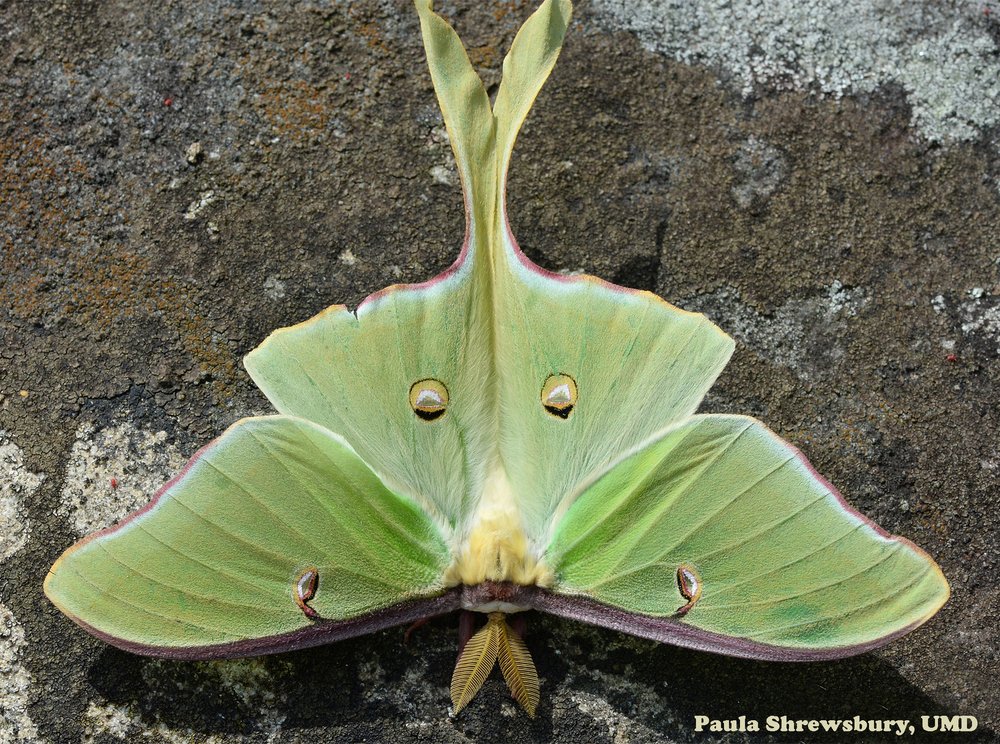Saving Hercules and a moon moth: Hercules beetle, Dynastes tityus, and Luna moth, Actias luna

Attracted by a parking lot light at night, this handsome Hercules beetle deposited on the asphalt below stood little chance of surviving long enough to find a mate.

Beneath a security light at a day care center, a beautiful male luna moth is imperiled by small feet as children arrive early in the morning.
Early one morning last week on a visit to a supermarket in rural Maryland, I was chagrined to see a gorgeous male Hercules beetle spinning helplessly on its back beneath a tall lamp post in a parking lot. We met Hercules beetles in a previous episode and learned of their sylvan life cycles recycling organic plant matter and wooing mates. With not a tree to be found in the vast parking lot desert, the presence of a break dancing, belly-up beetle was perplexing. Skip back three years to an early morning discovery of a Luna moth on a sidewalk outside a day-care center which raised a similarly puzzling question. Luna moths, aptly named in honor of the moon, are denizens of forests where males fly by the light of the moon and stars to find mates and females navigate the darkness to deposit eggs on the leaves of trees. The common feature of both of these unnatural appearances is, of course, the presence of powerful overhead light sources, one illuminating a parking lot and another guarding the entryway to a day care center at a church. These beautiful but hapless insects should have followed the sage advice given to Heather O’Rourke in Poltergeist “do not go into the light”, but unfortunately most insects have not seen the movie.
Just after dawn, I found this Hercules beetle break dancing beneath a lamppost in a parking lot. This handsome night-flier likely was attracted to the light during the night and crashed to the asphalt below. Getting off his back looked challenging. After a rescue and release in a nearby forest, he quickly disappeared inside a rotting stump.
Why are beetles, moths, and other insects attracted to lights? Scientists believe that night flying insects use light sources from distant stars and the moon to orient their flight. When light from these sources arrives at earth their light beams are largely parallel. By flying at a fixed angle to these beams, nocturnal insects maintain a straight course. However, beams of light from a nearby security light, parking lot light, or flashlight are still diverging from their source. When insects encounter these light beams, they constantly correct their angle of flight which causes them to spiral ever-inward to the source. Several other theories have been advanced to help explain the not yet fully understood reason why insects are attracted to light. In addition to attracting insects that will perish in a parking lot or on a sidewalk, light pollutions can disrupt normal behaviors such as the wondrous mating rituals of bioluminescent insects like the iconic fireflies we met in a previous episode.
Uh oh, Luna moth down! Attracted by security lights at night, this handsome moth wound up on the sidewalk by morning. Will careless feet be its demise or hordes of hungry ants dismember it? Nah, giant fingers first rescue the moth, and then it’s off to a photoshoot before being released in the forest far away from bright lights.

High intensity lights in parking lots attract many insects that may not survive a day in this unnatural and hostile location.
So, what can we do to reduce insect carnage related to light pollution? The trick seems to be balancing illumination for human safety with the needs of animals and plants for natural patterns of light evolved over eons. Scientists suggest that every parking lot or sport stadium does not need to be illuminated all night every night. Shielding light sources from above to prevent light escaping upward and interfering with night flying insects might also help. Low-lying lights along trails can be shielded both above and below to avoid disturbing nocturnal ground-dwelling insects. Dimming lights whenever possible may help reduce general light scatter to the sky above. Also, turning lights off when they are not needed and installing motion detectors to activate lights only when needed will reduce unnecessary illumination. For insects with well defined emergence patterns like mayflies and fireflies, reducing lights during periods of flight associated with mating activity could help preserve species whose behaviors are hard-wired to natural light patterns. And when you find one of these creatures stranded in a dangerous place beneath a light, give them a break and transport them back to more natural surroundings nearby. With a little thought and care we can all help the natural world become a little darker and more animal and plant friendly. With all of this in mind, as I put this episode of Bug of the Week to bed, I will be sure to turn off the lights both outside and inside.
Acknowledgements
The great read “Light pollution is a driver for insect declines” by C.S. Owens, P. Cochard, J.D. Durrant, B. Farnworth, E. K. Perkin, and B. Seymour was consulted for this episode.
This post appeared first on Bug of the Week